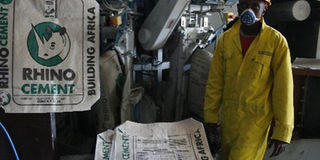Athi River Mining to double production

Employee of Athi River Mining Company. Listed cement maker Athi River Mining has posted a 20 per cent increase in profit after tax for the first six months of the year due to increased sales of cement. Photo: FREDRICK ONYANGO
What you need to know:
- Athi River Mining Ltd will spend over Sh34.1 billion ($400 million) on the construction of new cement plants in Tanzania and Kenya.
- Next year, ARM will embark on the construction of a Sh21.3 billion ($250 million) clinker factory in Kenya to boost its capacity to five million tonnes of cement.
- “We are looking at doubling our cement production in Kenya within a four-year period from 2.5 tonnes last year,” said Mr Paunrana.
Athi River Mining Ltd will spend over Sh34.1 billion ($400 million) on the construction of new cement plants in Tanzania and Kenya.
The company’s chief executive, Mr Pradeep Paunrana, said a plant in Tanga would have capacity of 1.2 million tonnes per year and will be completed within five months.
“The entire Tanga project coupled with the Dar es Salaam grinding plant that has been in operation since last year cost Sh12.8 billion ($150 million),” he said.
Next year, ARM will embark on the construction of a Sh21.3 billion ($250 million) clinker factory in Kenya to boost its capacity to five million tonnes of cement.
An extra Sh4.2 billion ($50 million) will be spent on other projects, according to the firm.
“We are looking at doubling our cement production in Kenya within a four-year period from 2.5 tonnes last year,” said Mr Paunrana.
He said the company was working on increasing its market share in Tanzania from 17 per cent to 25 per cent in the next 12 months.
“We aggressively ventured into the Tanzanian market because growth in the Kenyan market was quite slow, especially because of the 2012 elections and the recent Westgate Mall attack,” said Mr Paunrana.
The opening of a Tanzania firm in October last year saw Athi River Mining grow its sales and profit by double digits in the first half of the year.
Other firms like Bamburi Cement, East African Cables, BOC Gases, and Sameer Africa said their sales dropped by between one per cent and 17 per cent in the same period.
ARM said increased demand of its Rhino cement led to a sales rise of 28 per cent to Sh6.4 billion in the first six months to June this year, a development that increased its net profit by a similar margin to Sh702.8 million.
Mr Paunrana, however, added that there would be immense growth in the cement industry in the second half of the year buoyed by the thriving real estate industry.
According to a Kenyan market update report 2013 by CW Group, a US-based cement consultancy company, despite low rates recorded in 2012, cement demand is projected to expand 10 per cent per year on average and exceed 6.3 million tonnes annually by 2017.
Kenya’s cement consumption per capita is also forecast to reach an important milestone in 2014 when it will surpass, for the first time in its history, 100 kilos per inhabitant.
Kenya National Bureau of Statistics data show that production in the industry climbed 3.5 per cent from 2012 to 4.64 million tonnes this year.
The growth is attributed to government spending on infrastructure projects like upgrading ports and constructing new roads, as well as home builders trying to meet an annual deficit of 440,000 units, according to Kestrel Capital East Africa Ltd.
ARM mainly uses clinker to produce cement.
Being the main ingredient for cement production, about 45 per cent of the raw material is imported to seal the deficit.
CW Group statistics state that Kenya is still heavily dependent on large clinker imports, with over 1.2 million tonnes imported in 2012 mostly from China.
This dependency is expected to continue as efforts targeted toward capacity expansion are mostly focused on cement grinding.
Apart from cement production, ARM also specialises in production of industrial minerals, chemicals, fertilisers, and other types of building products.
The diversity of its product range and its expansion in parts of East Africa are some of the facts that Mr Paunrana said contributed to the 28 per cent rise in cement sales for the nine-month period ending September 30, 2013.
“Our revenue grew 32 per cent to Sh10.2 billion ($120 million), boosting net income in the period to Sh1.06 billion from Sh826.5 million a year earlier,” said ARM.
Mr Paunrana said the company would soon start selling Eurobonds to help facilitate its expansion projects, “This will help us grow immensely as we look at closing the year on higher profits.”
He added that the Kenyan market is currently very promising. “It is a good market and cement consumption has been increasing throughout the region.”
Since the company’s shares were split late last year, ARM’s managing director said, the management has been focusing on increasing shareholder value through executing the growth strategy and using funds from lenders to support capacity expansion.
The firm’s entry into the Eurobonds market will set the pace for other Kenyan companies to follow suit.





